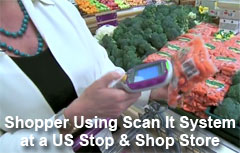From SCDigest's OnTarget e-Magazine
July 6, 2011
RFID and AIDC News: Will Bar Code Base Self-Scanning Systems Doom Item-Level RFID Tagging in CPG to Retail?
Increasing Number of Retailers Giving Mobile Wireless Devices to Consumers and Telling them to Scan Away; 10% Bump in Sales per Visit
SCDigest Editorial Staff
As we've noted in the past, the initial vision of an RFID-enabled consumer packaged goods to retail supply chain that was the foundation of the electronic product code (EPC) movement starting in 2003 has largely floundered, even as there is now at last strong activity in such areas as apparel (see RFID in CPG to Retail - What Really Happened?).
SCDigest Says: |
 |
| Scan It customers spend on average about 10% more than customers that don't use the system, in large part driven by the deal promotions."
|
|
What Do You Say?
|
|
|
|
While many believe that someday the value prop for item-level RFID in mainstream retail (grocery, mass merchandise) will emerge as tag costs go low enough, we wonder if the emergence and apparent popularity of bar code-based mobile self-scanning systems will mean the need for or potential advantages of item-level RFID in most retail applications will never get off the mat.
The basic concept of these mobile self-scan systems is this : shoppers are given small mobile wireless devices as they begin their shopping, scan item bar codes to view product information, see and claim discount offers, and ultimately put the item into their electronic as well as physical shopping cart, making checkout fast and easy.
There are several such system offerings for retailers in the marketplace, primarily deployed in Europe, though Swedish retailer Ahold has depoyed its "Scan It" system not only in several Euro countries but also in about half of its Stop & Shop and other US store banners. All told, Stop & Shop says the system has already been used about 10 million times in the US.
Carrefour, the world's second largest retailer behind WalMart, has also started to roll out a system in parts of Europe, based on the My-Scan system from a technology provider called Re-Vision, which says UK retailer Tesco is also a customer, among others.
These scanning systems usually work something like this:
A customer enters the store and goes to a self-service kiosk that contains the wireless terminals, which use a small, easy to hold form factor (Motorola MC17s appear to be popular). After scanning a loyalty card, a scanner holder slot lights up and unlocks a unit for that shopper, who would just hold the device in a hand or put it in new holders for the devices added to shopping carts in these stores. Alternatively, a store clerk could manage the scanner checkout process.
 The shopper scans the bar code on a product or on a board (say for produce) to see the price in an easy to read fashion on the display, along with other product information. Importantly, the display will also indicate any available "electronic coupons," other sorts of deals (e.g., buy 1, get one free), and potentially even deals for different products in the same category, such as the store brand for the item. Ultimately, these systems could eliminate the need for shelf labels, which are a huge cost and headache for many grocers and other retailers (though in the US such labels are currently mandated by many state laws). The shopper scans the bar code on a product or on a board (say for produce) to see the price in an easy to read fashion on the display, along with other product information. Importantly, the display will also indicate any available "electronic coupons," other sorts of deals (e.g., buy 1, get one free), and potentially even deals for different products in the same category, such as the store brand for the item. Ultimately, these systems could eliminate the need for shelf labels, which are a huge cost and headache for many grocers and other retailers (though in the US such labels are currently mandated by many state laws).
Controls on the device give the customer the choice to purchase (add to cart) the item, change the quantity, return an item to the shelf from the cart, etc.
While the customer moves throughout the store, other deals or promotions are sequentially displayed on the device, potentially driven by information known about the shopper from the loyalty program.
Products the customer adds to the cart will be placed in re-usable or other bags, rather than just the cart itself, to speed up the checkout processes,
At any time, the customer can review what they have purchased and what the total cost is.
(RFID and AIDC Story Continued Below)
|